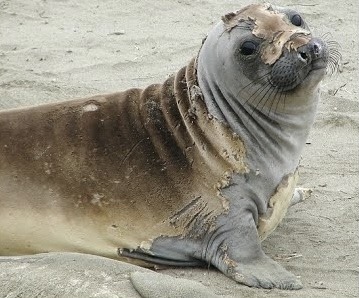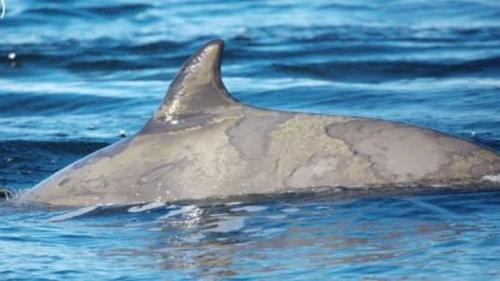A Consideration
A consideration
Selkie molting season
im sorry seals molt? my association with that word is insects so i am confused and intrigued
They do! I’d say most species of animals sloughs off “old” parts of their bodies at some point of their lives in some capacity. The word “molting” is used as a catch-all term for this process, although exactly what body part they shed and how they do it varies from animal to animal. Arthropods grow an entire new exoskeleton and shed the old one, but for most other animals, this process only involves shedding the outermost layer of their bodies, the pelage and/or their first layer of skin. Reptiles are quite famous for this because they sometimes manage to come out of their old skins and leave them almost fully intact as if they were kigurumi pajamas:

Mammals tend to mostly only shed fur or hair, growing thicker fur during colder months and losing it in favor of shorter fur during warmer months. How obvious this is depends on the climate, though. It’s quite perceptible in mammals that live in the arctic whose fur changes color depending on the season:


But even the difference between the summer coats and winter coats of domestic dogs can be palpable if you live in places with colder climates!

(I’m quite fascinated by this because I was born and raised in a tropical country and my dogs look the same all year round heh)
But back to the seals. Pinnipeds don’t really use their fur to keep warm like other mammals do, but they still have it, and they have to shed their old coats and grow new ones accordingly, which they do once a year!
In elephant seals, this process is so sudden and so extreme it’s called catastrophic molting. They don’t only lose their fur, but also a layer of dead skin all at once and this forces them to stay on land for a full month without swimming (and therefore, without hunting and eating) until the process is fully done. Because molting requires redirecting blood flow towards the skin instead of to their vital organs as usual, if they swam in the cold waters they’re usually accustomed to while molting, they’d freeze!


Bonus fun fact: despite having lost their fur during the evolution process, cetaceans like whales and dolphins also go through a molting process where they lose a layer of dead skin, which they scrape off by rubbing against rocks and rolling on sand banks.


It’s been recently discovered (as of 2020!) that the reason whales migrate annually from arctic waters to tropical waters is the exact same reason elephant seals spend a month on land: to molt! It’s much easier for a whale to keep warm while shedding its skin in warm waters than it is in cold waters.
-
 too-queer-for-school liked this · 4 months ago
too-queer-for-school liked this · 4 months ago -
 frakin-fantastic reblogged this · 4 months ago
frakin-fantastic reblogged this · 4 months ago -
 frakin-fantastic liked this · 4 months ago
frakin-fantastic liked this · 4 months ago -
 cant-apult reblogged this · 4 months ago
cant-apult reblogged this · 4 months ago -
 justabananainabox liked this · 4 months ago
justabananainabox liked this · 4 months ago -
 koala-bookworm liked this · 4 months ago
koala-bookworm liked this · 4 months ago -
 dabblingreturns reblogged this · 4 months ago
dabblingreturns reblogged this · 4 months ago -
 carciinogen liked this · 4 months ago
carciinogen liked this · 4 months ago -
 hufflefuckersss liked this · 4 months ago
hufflefuckersss liked this · 4 months ago -
 glitternotyou liked this · 4 months ago
glitternotyou liked this · 4 months ago -
 yak-leather-whips reblogged this · 4 months ago
yak-leather-whips reblogged this · 4 months ago -
 ceyuray liked this · 4 months ago
ceyuray liked this · 4 months ago -
 uwuzard reblogged this · 4 months ago
uwuzard reblogged this · 4 months ago -
 maytheamazing reblogged this · 4 months ago
maytheamazing reblogged this · 4 months ago -
 maytheamazing liked this · 4 months ago
maytheamazing liked this · 4 months ago -
 alinnsurana reblogged this · 4 months ago
alinnsurana reblogged this · 4 months ago -
 alinnsurana liked this · 4 months ago
alinnsurana liked this · 4 months ago -
 voyagerscompass liked this · 4 months ago
voyagerscompass liked this · 4 months ago -
 queerloquial reblogged this · 4 months ago
queerloquial reblogged this · 4 months ago -
 emtertaintment reblogged this · 4 months ago
emtertaintment reblogged this · 4 months ago -
 pandashaman reblogged this · 4 months ago
pandashaman reblogged this · 4 months ago -
 theharlotofferelden reblogged this · 5 months ago
theharlotofferelden reblogged this · 5 months ago -
 cosmiclattetigeress reblogged this · 5 months ago
cosmiclattetigeress reblogged this · 5 months ago -
 cosmiclattetigeress liked this · 5 months ago
cosmiclattetigeress liked this · 5 months ago -
 beefstatic liked this · 5 months ago
beefstatic liked this · 5 months ago -
 clayhouse liked this · 5 months ago
clayhouse liked this · 5 months ago -
 z37q reblogged this · 5 months ago
z37q reblogged this · 5 months ago -
 thescouring liked this · 5 months ago
thescouring liked this · 5 months ago -
 unthinkingclunk reblogged this · 5 months ago
unthinkingclunk reblogged this · 5 months ago -
 strengthisyellow reblogged this · 5 months ago
strengthisyellow reblogged this · 5 months ago -
 14brooms reblogged this · 5 months ago
14brooms reblogged this · 5 months ago -
 pantzipper reblogged this · 5 months ago
pantzipper reblogged this · 5 months ago -
 kevinthenerd reblogged this · 5 months ago
kevinthenerd reblogged this · 5 months ago -
 divination-bi-ct-h liked this · 5 months ago
divination-bi-ct-h liked this · 5 months ago -
 somewhitedude001 reblogged this · 5 months ago
somewhitedude001 reblogged this · 5 months ago -
 somewhitedude001 liked this · 5 months ago
somewhitedude001 liked this · 5 months ago -
 boliviancub reblogged this · 5 months ago
boliviancub reblogged this · 5 months ago -
 imbibyebi liked this · 5 months ago
imbibyebi liked this · 5 months ago -
 moon-drunk reblogged this · 5 months ago
moon-drunk reblogged this · 5 months ago -
 cowwatcher liked this · 5 months ago
cowwatcher liked this · 5 months ago -
 alexalfurinn liked this · 5 months ago
alexalfurinn liked this · 5 months ago -
 xyloid-devices reblogged this · 5 months ago
xyloid-devices reblogged this · 5 months ago -
 xyloid-devices liked this · 5 months ago
xyloid-devices liked this · 5 months ago -
 the-tide-pools liked this · 5 months ago
the-tide-pools liked this · 5 months ago -
 thelastmuppet reblogged this · 5 months ago
thelastmuppet reblogged this · 5 months ago -
 thelastmuppet liked this · 5 months ago
thelastmuppet liked this · 5 months ago -
 homosectionals liked this · 5 months ago
homosectionals liked this · 5 months ago -
 shadowedconfidence reblogged this · 5 months ago
shadowedconfidence reblogged this · 5 months ago -
 shadowedconfidence liked this · 5 months ago
shadowedconfidence liked this · 5 months ago -
 thegenewilderside reblogged this · 5 months ago
thegenewilderside reblogged this · 5 months ago
More Posts from Translunaryanimus


The little guys! I put them all in one cause I've seen some people mix up Dwarves/Gnomes/Halflings before and figured this would be a fun way to show the differences (and to make Halflings and Gnomes more distinct than they are in base 5e).

I forgot these 6. Whoops!



Large amount of DnD animal people "Wilderfolk" from a sketch session.
Wilderfolk are made 1 of 2 ways. They were either once an animal given Sentience and an upright stance by Magic, The Gods, or a Patron, or they were a person (usually assumed human) cursed (or blessed) into their shape by Magic, The Gods, or a Patron. Method of transformation doesn't entirely matter and Wilderfolk largely end up with a standardized appearance regardless.
The different group names are a courtesy, given to the Wilderfolk BY the Wilderfolk to build a sense of community. Some names are broader than others due to inconsistent naming conventions, but each group name is fairly consistent in telling you what to expect.
Below the cut are the group names and what each group is comprised of.
Whippho - Hippos
Strix - Owls
Leonin - Lions
Loxodon - Elephants
Locathah - Fish and Eels
Aaracokra - Birds of Prey NOT including Owls
Yuan-Ti - Snakes. Typically Poisonous
Harengon - Hares and Rabbits. If it's a Lagomorph, it's a Harengon
Hadozee - Monkeys and Great Apes
Kenku - Corvids such as Crows, Ravens, Jackdaws, etc.
Lacertian - Lizards NOT including dragons
Tortle - Turtles and Tortoises
Bovid - Bovines. Cows, Buffalo, and Antelopes
Tabaxi - Big cats NOT including Lions
Grung - Anuran species like Frogs, Toads. Salamanders on occasion
Thri-Kreen - True Insects NOT including Lepidoptera. May sometimes also resemble arthropods
Urkta - Bears
Loupe - Wolves and Big Dogs
Vulhui - Foxes
Fynselk - Seals and Sea Lions
Cancryan - True Crabs and False Crabs
Tineid - Moths and Butterflies
Eqapal - Horses
Murin - Rats, Mice, and similar Rodents such as Squirrels
Xenarthine - Sloths, Anteaters, and Armadillos. Can also include pangolins
@elinex I'm sorry but I'm not
ⓘ A sewing machine is a device that provides a several-fold increase of the speed at which you can make mistakes
I just discovered foodtimeline.org, which is exactly what it sounds like: centuries worth of information about FOOD. If you are writing something historical and you want a starting point for figuring out what people should be eating, this might be a good place?



Large amount of DnD animal people "Wilderfolk" from a sketch session.
Wilderfolk are made 1 of 2 ways. They were either once an animal given Sentience and an upright stance by Magic, The Gods, or a Patron, or they were a person (usually assumed human) cursed (or blessed) into their shape by Magic, The Gods, or a Patron. Method of transformation doesn't entirely matter and Wilderfolk largely end up with a standardized appearance regardless.
The different group names are a courtesy, given to the Wilderfolk BY the Wilderfolk to build a sense of community. Some names are broader than others due to inconsistent naming conventions, but each group name is fairly consistent in telling you what to expect.
Below the cut are the group names and what each group is comprised of.
Whippho - Hippos
Strix - Owls
Leonin - Lions
Loxodon - Elephants
Locathah - Fish and Eels
Aaracokra - Birds of Prey NOT including Owls
Yuan-Ti - Snakes. Typically Poisonous
Harengon - Hares and Rabbits. If it's a Lagomorph, it's a Harengon
Hadozee - Monkeys and Great Apes
Kenku - Corvids such as Crows, Ravens, Jackdaws, etc.
Lacertian - Lizards NOT including dragons
Tortle - Turtles and Tortoises
Bovid - Bovines. Cows, Buffalo, and Antelopes
Tabaxi - Big cats NOT including Lions
Grung - Anuran species like Frogs, Toads. Salamanders on occasion
Thri-Kreen - True Insects NOT including Lepidoptera. May sometimes also resemble arthropods
Urkta - Bears
Loupe - Wolves and Big Dogs
Vulhui - Foxes
Fynselk - Seals and Sea Lions
Cancryan - True Crabs and False Crabs
Tineid - Moths and Butterflies
Eqapal - Horses
Murin - Rats, Mice, and similar Rodents such as Squirrels
Xenarthine - Sloths, Anteaters, and Armadillos. Can also include pangolins
